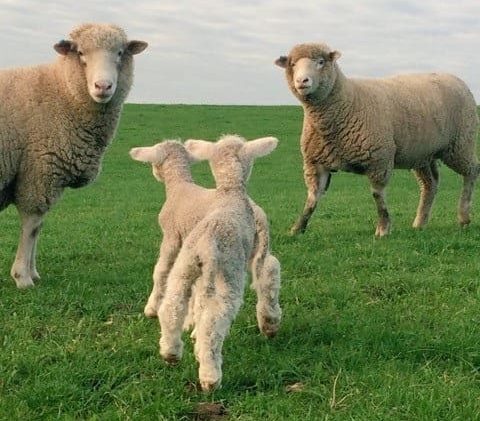
The shift to sheep meat production is continuing.
AUSTRALIA’S latest sheep producer sentiment survey points to only a small reduction in the national lamb turn-off next year and a continuing move out of specialist Merino wool production toward sheep meat and shedding sheep.
The survey results released by Meat & Livestock Australia and Australian Wool innovation this morning also indicates that sentiment among Australian sheep meat producers who responded has increased 84 points over the past twelve months, attributed to the improved seasonal outlook and lamb and mutton prices.
The survey showed that respondent producers are equally split between wanting to increase or decrease their flocks, with prime lambs overtaking Merinos within the 27 million lambs reportedly held by producers.
Analysis of the forecast change in the number of lambs suggests in 2025 a reduction of about 250,000 lambs is expected, or about 1 percent of the estimated 2024 lamb flock size.
And analysis of the lamb marking success among different breed flocks from 2023 to 2024 suggests that the expected drop in lamb production going forward will mainly be among Merino flocks.
Comparing the numbers of lambs reportedly marked by survey respondents this year to that reported in 2023, it seems the overall marking percentage has dropped 6pc, from 87pc to 81pc, although the marking percentages increased in all sheep breed categories except Merinos – 87pc in 2023 down to 81pc this year. The reported increases in marking percentages from 2023 to 2024 for other producers were prime lamb 92pc to 113pc; first cross 87pc to 93pc; shedding 89pc to 92pc; dual purpose 87pc to 95pc and ‘other’ 90pc to 108pc.
MLA senior market analyst Erin Lukey said the expected 1pc reduction in the lamb flock size highlights the importance of considering the reported changes in flock size rather than just producers’ disposition to change.
“Differing conditions across states will impact regional flock sizes, but also the intentions of different sized enterprises.
“Growth in the New South Wales flock has combatted the climate driven decrease across other states, resulting in a level national flock,” she said.

Merino ewes and lambs.
The survey has also revealed changes in the lamb flock profile with prime lambs (38pc) remaining above Merinos (35pc) within the 27 million lambs on hand. The Merino lamb component fell from 37pc to 35pc over the past year and shedding lambs lifted from 5pc to 8pc of the lamb flock, MLA said.
“Reasons as to why include a struggle to access labour for shearing, rising input costs and poor wool prices,” Ms Lukey said.
The survey found that producer net sentiment for the sheep meat sector has lifted from -42 points in October 2023, to +42 points in October 2024.
All states other than Western Australia reported a positive outlook for the sheep meat sector, with New South Wales (+55), Victoria (+52) and Queensland (+41) reporting the highest numbers.
MLA said Western Australian producers, who face a series of challenges, including the cessation of live sheep exports, tough market conditions and dry season conditions, reported a sentiment figure of -2 points, although this is a 69-point increase compared to the 2023 figure.
Ms Lukey said this edition of the SPIS had the largest response rate ever, collecting 2,579 producer responses, representing 10% of sheep producers across the country.
“This gives us a strong indicator on the state of the industry and describes producers’ intentions for the year ahead.
“Nearly equal proportions of producers are intending to increase (40pc) or decrease their flock (39pc),” she said.
“This has shifted from last year’s survey, when more producers were looking to decrease their flock.
“The reasons why depend on which state you live in,” Ms Lukey said.
“Western Australian and South Australian producers, who have had drier weather than the eastern states, were more likely to want to reduce their flocks at 51pc and 49pc respectively.
“47pc of NSW producers indicated a desire to grow their flocks, with the most common reason being an expectation of higher lamb prices in 2025.”
The Sheep Producer Intentions Survey was designed by MLA and AWI to support the industry with reliable data and is used by MLA and the Australian Bureau of Statistics. It is one of the inputs into the MLA sheep meat industry forecasting models.
To view the full results please visit: Sheep Producer Intentions Survey: October

It is obvious that the tactics of AWI to live in the past are doing a good job of shrinking the Merino industry. AWI’s failure to recognise that the modern Merino, plain-bodied, highly fertile, high growth rates and fast growing wool is the future is costing the industry dearly, let alone the reputation of AWI.
Still 90 percent of producers failed to submit the producer survey and I’m sure amongst them are many who are negative on the sheep industry and are exiting in favour of more profitable industries such as cropping.
I think it’s safe to say that this data may not reflect reality. Lamb and ewe numbers will be down significantly more than this survey suggests. A significant increase in ewe mortality coupled with a significant decline in autumn and early winter marking percentages in the south-west of Victoria and south-east of South Australia will impact the 2025 turn-off. A large up turn in terminal sire use in flocks as well as significant sell off or decrease in ewe numbers in the mixed farming zone will also impact numbers. Non-weaned ewes and a poor spring in many areas in September and October will also impact ewe condition and conception rates in the autumn next year.
I’m not sure if there is enough ground truths sought when making industry outlooks?